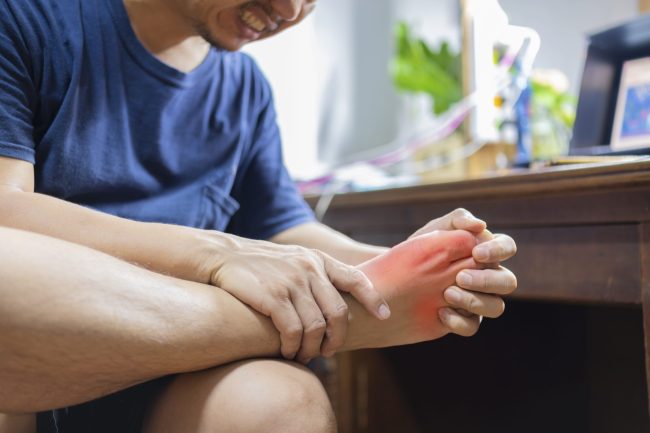Gout is a common and painful form of arthritis. It causes swelling, redness, warmth and stiffness in the joints. Gout occurs when uric acid builds up in the blood.
In this Channel you can learn more about Gout: Gout Home Remedy
This happens if the body produces too much acid or it is not properly eliminated, or if too much purine-containing foods, such as liver and dried legumes, are consumed. Pseudogout has similar symptoms and is sometimes confused with gout. However, it is caused by calcium phosphate and not uric acid. Gout often attacks the big toe first. It can also attack the ankles, heels, knees, wrists, fingers and elbows.
Symptoms
Gout is almost always preceded by hyperuricemia (elevation of uric acid in the blood) and is therefore a silent disease until it triggers the first attack of gouty arthritis, which is usually in the first toe (podagra). From that first crisis, gout can affect other joints such as the knee, hands, even generating polyarthritis (inflammation of many joints simultaneously) in some cases. Gout, if left untreated, can lead to irreversible joint destruction.
It has been known for some years that gout is not an exclusively joint disease since uric acid can be deposited in other structures, such as blood vessels. The inflammation generated by the acid in the vascular wall leads to an increased cardiovascular risk, so that today, like hypercholesterolemia, hypertriglyceridemia or diabetes, gout is considered an independent cardiovascular risk factor.
Here you will find all the Symptoms of Gout: Gout Symptoms
How is it diagnosed?
Gout cannot be diagnosed with a simple blood test, as many people have elevated uric acid levels in the blood, but never develop gout disease. Rather, gout is diagnosed from the fluid in the inflamed joint. This fluid is viewed under a microscope to detect sodium urate crystals.
The fluid is removed by a needle puncture of the inflamed joint (a procedure called arthrocentesis). Removing the fluid can reduce the pressure in the joint and thus reduce pain. Failure to find these crystals does not necessarily rule out the diagnosis of gout. Occasionally crystals are not found the first time, but if they are found, more fluid is withdrawn at a later time during a subsequent attack.
Because gout can cause chronic joint pain and involve other joints, it is extremely important that an accurate diagnosis be made. Then your doctor can prescribe the appropriate treatment.
If you have already been diagnosed with Gout here you can find many natural remedies to relieve the pain: Home Remedies For Gout
How is Gout treated?
Traditionally, treatment for acute cases of gout has consisted of colchicine, which can be effective if given early in the attack. However, colchicine can cause nausea, vomiting, diarrhea and other side effects. Doses may be better tolerated if they are low and should be reduced in patients with renal disorders. Nonsteroidal anti-inflammatory drugs (NSAIDs) are “aspirin-like” drugs that can relieve inflammation and pain in joints and other tissues. NSAIDs, including indomethacin and naproxen, have been adopted as the best choice for the treatment of most acute attacks of gout. No particular NSAID has been proven to be better than another. The most rapid relief of symptoms is achieved by high doses of fast-acting NSAIDs. Although these drugs may cause stomach irritation, ulcers, or diarrhea, they are usually well tolerated if given for a short time.
Some people cannot take NSAIDs because of other medical conditions, such as ulcers or kidney problems, or the use of anticoagulants. Corticosteroids are important options in patients who cannot take NSAIDs or colchicine. Their administration, either orally or by intramuscular or joint injections, can be very effective in the treatment of gout attacks. Resting the affected joint and applying cold compresses to the area can also help relieve pain.
FYRON G1 CURCUMIN + FYRON G2 BOSWELLIA is a very powerful natural supplement to fight Gout: Gout Treatment
